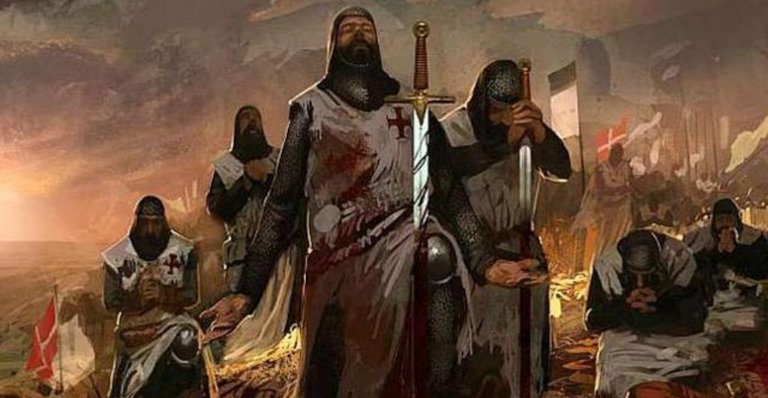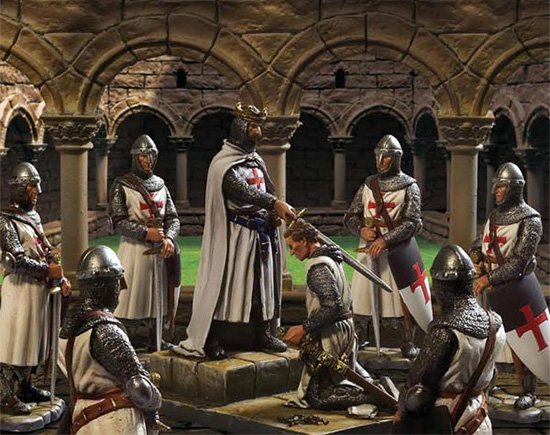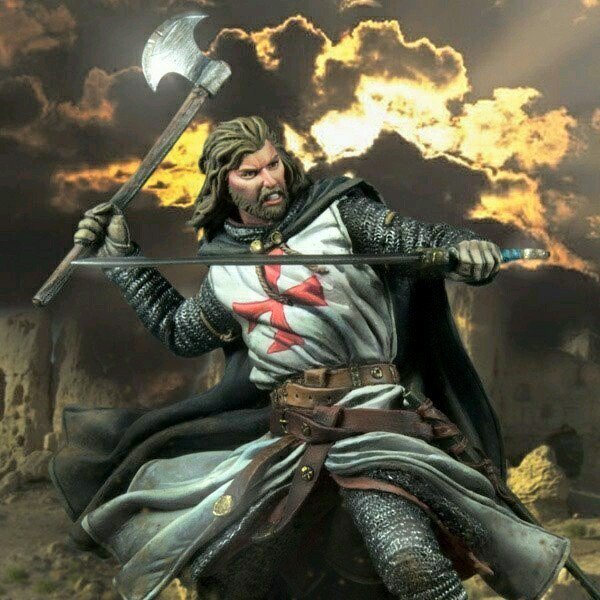Templar warriors

author image
The Order of the Poor Companions of Christ and the Temple of Solomon (in Latin: Pauperes Commilitones Christi Templique Salomonici), also called the Order of the Temple, whose members are known as Knights Templar, was one of the most powerful Christian military orders of the Middle Ages. It remained active for just under two centuries. It was founded in 1118 or 1119 by nine French knights led by Hugo de Payns after the First Crusade. Its original purpose was to protect the lives of Christians who made a pilgrimage to Jerusalem after its conquest. The order was recognized by the Latin patriarch of Jerusalem Garmond de Picquigny, who imposed as a rule that of the Augustinian canons of the Holy Sepulcher.
Approved officially by the Catholic Church in 1129, during the Council of Troyes (celebrated in the cathedral of the same city), the Order of the Temple grew rapidly in size and power. The Knights Templar had as a distinctive white mantle with a red cross pate drawn on it. Militarily, its members were among the best trained units that participated in the Crusades. The non-combatant members of the order managed a complex economic structure within the Christian world. They created, even, new financial techniques that constitute a primitive form of the modern bank. In addition, he built a series of fortifications throughout the Mediterranean Sea and the Holy Land.
The success of the Templars is closely linked to the Crusades. The loss of the Holy Land led to the disappearance of support for the order. In addition, the rumors generated around the secret ceremony of initiation of the templarios created a great distrust. Philip IV of France, heavily indebted to the order and frightened by his growing power, began to put pressure on Pope Clement V with the aim of taking measures against its members. In 1307, a large number of Templars were imprisoned, induced to confess under torture and burned at the stake. In 1312, Clement V yielded to the pressures of Philip IV and dissolved the order. Its abrupt eradication gave rise to speculations and legends that have kept alive until today the name of the Knights Templar.
The creation of the Templar warriors
Just created the kingdom of Jerusalem and elected Baldwin I as his second king, after the death of his brother Godfrey de Bouillon, some of the knights who participated in the First Crusade decided to stay to defend the Holy Places and the Christian pilgrims who traveled to them . Baldwin I needed to organize the kingdom and could not devote much resources to protecting the roads, since he did not have enough troops to do so. This, and the fact that Hugo de Payens was a relative of the Count of Champagne (and probably distant relative of Baldwin himself), led the king to grant those gentlemen a place to rest and maintain their equipment, as well as to grant them rights and privileges, Among which was an accommodation in his own palace, which was nothing but the mosque of Al-Aqsa, located at the time inside what had once been the site of the Temple of Solomon, when Baldwin left the mosque and its surroundings as a palace to set the throne in the Tower of David, all facilities passed, in fact, to the Templars, who thus acquired not only their headquarters, but their name.
In addition, King Baldwin took it upon himself to write letters to the most important kings and princes of Europe so that they would lend aid to the newly born order, which had been well received not only by political power, but also by the ecclesiastic, that the patriarch of Jerusalem was the first authority of the Church who canonically approved it. Nine years after the creation of the order in Jerusalem, in 1129 met the so-called Council of Troyes, which was responsible for drafting the rule for the newly born Order of the Poor Knights of Christ.
The council was headed by the papal legate D'Albano, and the bishops of Chartres, Reims, Paris, Sens, Soissons, Troyes, Orleans, Auxerre and other ecclesiastical houses of France attended. There were also several abbots, like Saint Stephen Harding, mentor of Saint Bernard, Saint Bernard of Clairvaux himself, and laymen like the Counts of Champagne and Nevers. Hugo de Payens explained to the assembly the needs of the order, so they decided, article by article, to the smallest details of it, from the way of fasting to the hair, through prayers, prayers and even armament.
Therefore, the oldest rule that is known is the one written in that council. Written almost certainly in Latin, it was based to a certain extent on habits and uses prior to the council. The main modifications derived from that until then the templarios lived under the Rule of San Agustín, that in the council was replaced by the Cistercian Rule (the one of San Benito, but modified) and that professed San Bernardo
The primitive rule consisted of an official act of the council and a regulation of 75 articles, among which are some such as:
Article X: Of eating meat in the week. In the week, if it is not on Easter Day of Nativity, or Resurrection, or Feast of Our Lady, or All Saints, that fall, it is enough to eat it three times, or days, because the habit of eating it, is understood It is corruption of the bodies. If on Tuesday there is a fast, on Wednesday you will be given plenty. On Sunday, as well as knights and chaplains, they are undoubtedly given two delicacies, in honor of the Holy Resurrection; the other servants are content with one and give thanks to God.
Once drafted, it was delivered to the Latin patriarch of Jerusalem Esteban de la Ferté, also called Esteban de Chartres, although some authors estimate that the editor could be his predecessor, Garmond de Picquigny, who modified it by eliminating 12 articles and introducing 24 new ones, among which was the reference to the gentlemen wearing only the white cloak and the sergeants a black cloak.
After receiving the basic rule, five of the nine members of the order, headed by Hugo de Payens, traveled first through France and then through the rest of Europe, in order to collect donations and recruit knights into their ranks. They initially went to their places of origin, in the certainty that they would be accepted and secured large donations. In this journey they managed to recruit in a short time about three hundred knights, without counting squires, men of arms and pages.
The beginning of the end
But the defeats against Saladin, Sultan of Egypt, drove them back. Thus, on July 4, 1187, at the Battle of the Horns of Hattin, which took place in the Holy Land, west of the Sea of Galilee, in the gorge known as the Horns of Hattin (Qurun-hattun), the crossed army, formed mainly by templar and hospital contingents under the command of Guido de Lusignan, king of Jerusalem, and Reinaldo de Châtillon, he faced the troops of Saladin. He inflicted a great defeat on them, in which the Grand Master of the Templars Gérard de Ridefort was taken prisoner and many Templars and Hospitallers perished. Saladin took possession of Jerusalem and ended the kingdom that Godfrey of Bouillon had founded. However, the pressure of the Third Crusade and the efforts of Richard I of England (called Heart of Lion) reached an agreement with Saladin to turn Jerusalem into a kind of free city for pilgrimage.
After the disaster of the Hattin Horns, things got worse. In 1244 Jerusalem, which had been recovered 16 years earlier by Emperor Frederick II through pacts with Sultan Al-Kamil, fell definitively. The Templars were forced to move their headquarters to San Juan de Acre, along with two other great monastic-military orders: the hospitable and the Teutonic.
The subsequent crusades (the Fourth, Fifth and Sixth), to which the Templars also enlisted, had no practical repercussions in the Holy Land or were demential episodes (such as the taking of Byzantium in the Fourth Crusade).
In 1248, Louis IX of France (later known as St. Louis) decided to call and lead the Seventh Crusade, but his goal is no longer Holy Land, but Egypt. The tactical error of the king and the plagues suffered by the crossed armies led to the defeat of Mansura and a subsequent disaster in which Louis IX himself fell prisoner. They were the Templars, held in high esteem by their enemies, who negotiated peace and lent the monarch the fabulous sum that made up the ransom to pay for his person.
After his expulsion from the Holy Land
The Templars would try to reconquer bridgeheads to penetrate again from Cyprus in the Near East. It was the only one of the three great orders of cavalry that tried it: the hospitable ones and the Teutonic knights oriented their interests to other places. The island of Arwad, lost in September 1302, was the last possession of the Templars in the Holy Land. The garrison commanders either died (Barthélemy de Quincy and Hugo de Ampurias) or were captured (Fray Dalmau de Rocabertí).
In the end, this effort would be rendered useless, not so much by lack of means or will as by the fact that the mentality had changed and no European power was interested in conquering the Holy Places. The Templars were isolated. In fact, one of the reasons why Jacques de Molay apparently was in France when he was captured was his intention to convince the French king to undertake a new crusade.
1129 - Acts of the Council of Troyes: Approval of the Rule by the council fathers.
1130 - De laude novae militiae: Saint Bernard praises the new cavalry and consecrates the Templars.
1135 - Council of Pisa: ratification of the Rule and concessions to the Templars.
1139 (March 29) - Omne Datum Optimum: Innocent II approves the rule and grants papal protection.
1144 (June 9) - Milites Templi: Celestino II provides ecclesiastical protection and encourages donations.
1145 (April 7) - Militia Dei: Eugenio III authorizes them to collect the tithe and to own their own graves.
1307 (November 22) - Pastoralis Praeminentiae: Clement V orders the arrest of the knights and the confiscation of their property.
1308 (August 12) - Faciens Misericordiam: Clement V creates the procedure to prosecute the Templars.
1308 (August 12) - Regnans in Coelis: Clement V convenes the Council of Vienne to discuss the Templars.
1312 (March 20) Council of Vienne: The suppression of the Order is decided.
1312 (March 22) - Vox in Excelso: Clement V dissolves the order of the Knights of Templars.
1312 (May 2) - Ad Providam Christi Vicarii: Clement V grants the properties of the Templars to the Hospitable Knights.
1312 (May 6) - Considers Dudum: Clement V determines the fate of the confessed and related.
The end of the Order

imagen source
The last Grand Master, Jacques de Molay, refused to accept the draft merger of military orders under a single king or widower (Project Rex Bellator, promoted by the great sage Ramón Llull), despite papal pressures. On June 6, 1306 was called to Poitiers by Pope Clement V for a final attempt, after whose failure, the fate of the order was sealed. Philip IV of France convinced (or rather, intimidated) Clement V, [citation needed] strongly linked to France, to initiate a trial against the Templars. The French crown was very indebted with the order, among other things, for the loan that his grandfather Luis IX requested to pay his ransom after being captured in the Seventh Crusade. In addition, the king sought a strong state, with the king to concentrate all power (compared to the Church and the various religious orders, such as the Templars)
In this work he had the inestimable help of Guillermo de Nogaret, chancellor of the kingdom, famous in history for having been the strategist of the Anagni incident, in which Sciarra Colonna had slapped Pope Boniface VIII. The Supreme Pontiff died of humiliation after a month. [Citation needed] Also from the Inquisitor General of France, William Imberto, better known as William of Paris; and of Eguerrand de Marigny, who in the end will seize the treasure of the order and administer it in the name of the king, until it is transferred to the order of the Hospitalers.
For this they used the accusations of a certain Esquieu de Floyran, a spy at the orders of both the Crown of France and the Crown of Aragon. [Citation needed]. They were accused of sacrilege to the cross, heresy, sodomy and adoration to pagan idols: to spit on the cross, to deny Christ through the practice of heretical rites, to worship Baphomet and to have homosexual contact, among other things.
It seems that Esquieu went to Jaime II of Aragon with the story that a Templar prisoner, with whom he had shared a cell, had confessed the sins of the order. Jaime did not believe him and threw him "with boxes ...", so Esquieu went to France to try his luck against Guillermo de Nogaret, who had no more will than the King, and who believed or did not believe in the same , did not lose the opportunity to use it for the operation that, in the end, led to the dissolution of the order.
The Cross red kick
On April 27, 1147, Pope Eugenius III, present in France at the time of the Second Crusade, attended the chapter of the order held in Paris. He granted the Templars the right to permanently carry a simple cross, but anchor or pate. , which symbolized the martyrdom of Christ. The color authorized for such a cross was red, which was the symbol of the blood shed by Christ, as well as of life. Since the crusade vote was accompanied by the taking of the cross, carrying it permanently symbolized the persistence of the crusade vote of the Templars
Use of the cross and colors
The cross was placed on the left shoulder, above the heart. In the case of knights, on the white mantle, symbol of purity and chastity. In the case of the sergeants, on the black or brown mantle, symbol of strength and value. Likewise, the banner of the Temple, which is called baussant or bauceant, means half-cast, since it also included these two colors, white and black.
Notable Templars
The nine founders
- Hugo de Payens
- Godfrey of Saint-Omer
- Geoffrey of Bisol
- Payen de Montdidier
- André de Montbard
- Arcimbaldo de Saint-Amand
- Hugo Rigaud
- Gondemaro
- Rolando

imagen source




Interesting one Jose, thanks for the effort, Lets hope the Knight loves it! PEACE!
..TH
@STEEMCHURCH
Thank you very much brothers, I hope our leader likes it, blessings for all of you and thousands of successes @steemchurch
This is a good write up.
From what you wrote I can say @sirknight is a Templar indeed.
Remember the basics. You were planned for God’s pleasure, formed for God’s family, created to become like Christ, shaped for service, and made for a mission! These aren’t just good points for teaching others or for leading a church. These are the purposes for which God made you!

Very true your words brother, we are warriors of God, we have his armor that is the word of the Lord, we always have to take his word to every corner of the world @hboi
A well researched and composed post. Good to share such an informative post with us @josegalanton
Thank you brother, for that I am here, so that you know the word of the Lord and all his history @bigssam
Mentioning sirknight makes me feel like I've found my mentorship in him. This post will take you places by God's grace. Keep it up
Wonderful post, it's nice to see people who contribute to the efforts of the church
Wow this is just a great piece, christain history at its peak! Am sure @sirknight will feel honoured to mentioned as part of the templars!
Wonderful i love this concept,all hail the great @sirknight
Wow whay an awesome posy
It really nice to have u on steemchurch today
Thanks for this amazing post
Mind blowing post, i'm Intrigued by the concept!
Wonderful post josegalanton, it's really inspiring....
Sirknight is indeed a man of valor
excellent work. Many see the Templars from the point of view of those who created the rumors of them, without realizing that the trial was taken by those who were interested in the Templars being dissolved.